It’s been a while since I’ve sat under my fabric hide and watched and waited; I loved every moment, even the little ant bites didn’t spoil the magic.
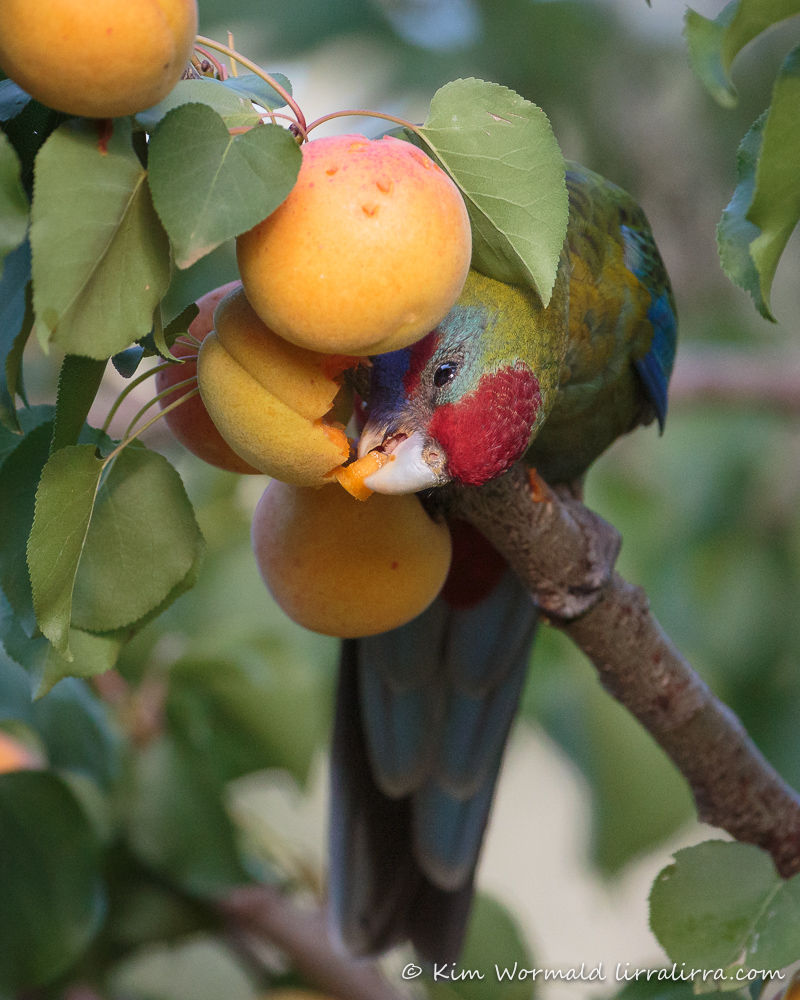
Crimson Rosella (Platycercus elegans) – juvenile
1/1000, f/5.6, ISO 3200
This juvenile Crimson Rosella appeared just as the sun disappeared which meant that I had to open the shutter to its widest and bump the ISO up to 3200 and hope that it would peek at me as it fed among the fruit. It was mainly eating fruit from the ‘wrong’ side of the tree so I felt lucky when it finally leaned through the foliage to test an apricot I could actually see. Young crimsons are often mistaken for another species as their markings are quite different from the adult plumage.
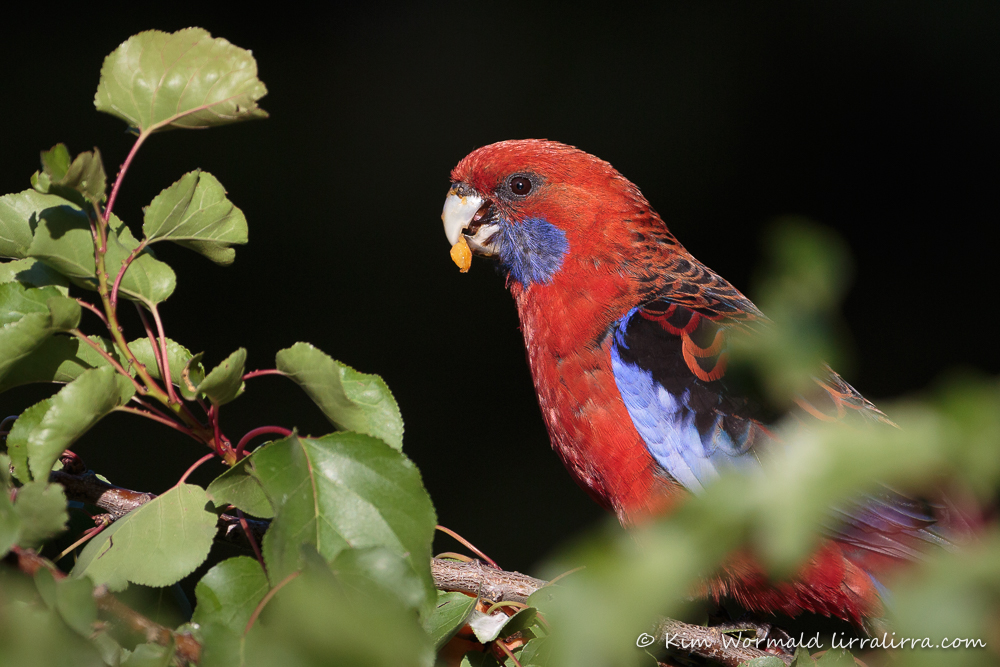
Crimson Rosella (Platycercus elegans) – adult
1/1600, f/7.1, ISO 800
Adult Crimson Rosella are stunning birds. Not everyone likes nature images with such a dark background but sometimes I think they add a great contrast, and maybe even drama. The image above was taken in the early evening when the sun was low on the horizon (as you can see from the catchlight) and the background was already deep in shadow.
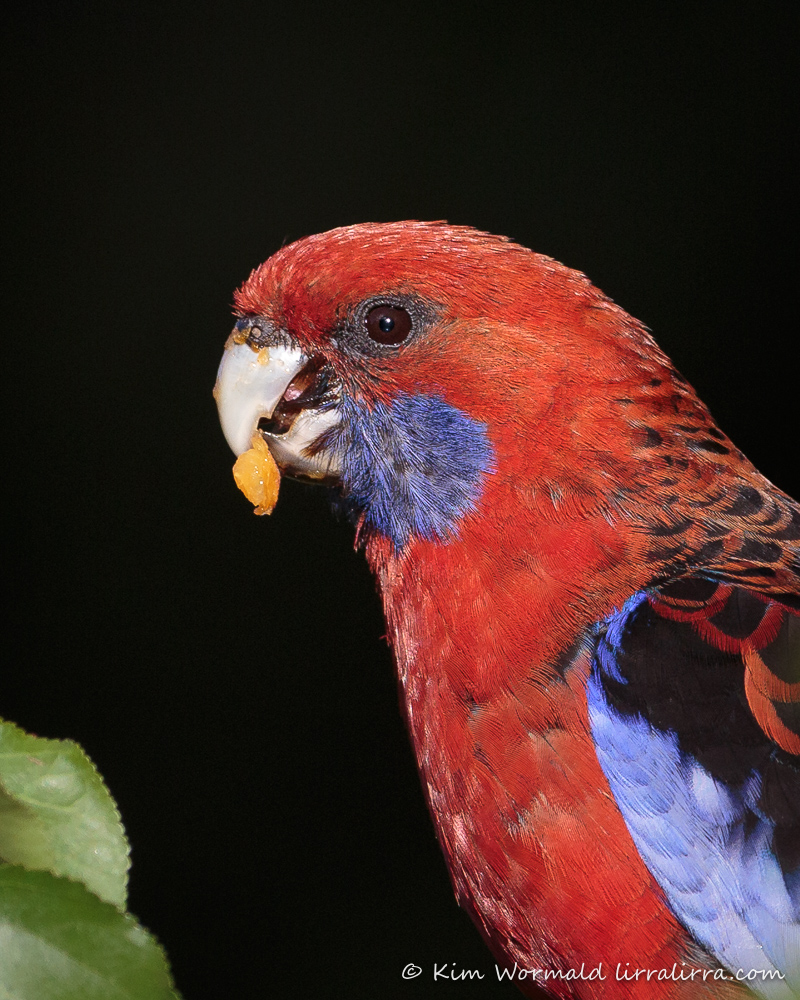
Crimson Rosella (Platycercus elegans) – adult
1/1600, f/7.1, ISO 800
This crop deletes the distracting leaves and shows more details of the crimson’s beautiful blue, red and black feathers – it also shows more detail of yet another juicy ripe apricot that I didn’t get to eat. Almost every apricot I have tasted recently has had a few nibbles taken from it.
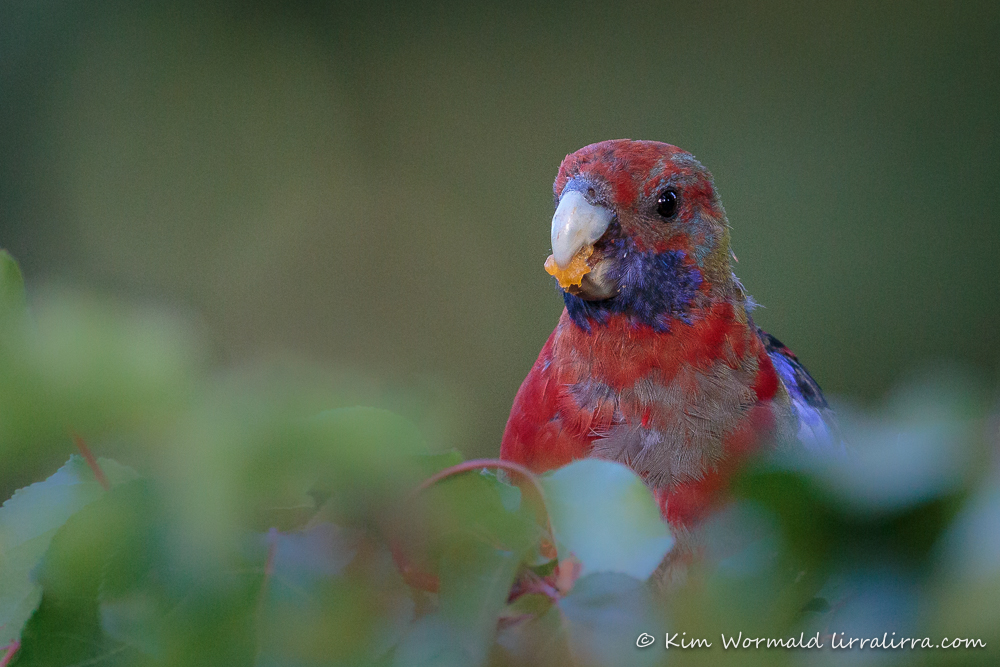
Crimson Rosella (Platycercus elegans) – leucistic
1/800, f/5.6, ISO 3200
At first I thought this bird was a sweet youngster when it popped up from a sea of leaves to look towards the camera (which must look like some kind of bunyip when covered with the camouflaged fabric). When I saw it more clearly I realised it is possibly leucistic. Leucism is a genetic mutation which causes colour to be reduced in all or some of the affected bird’s feathers.
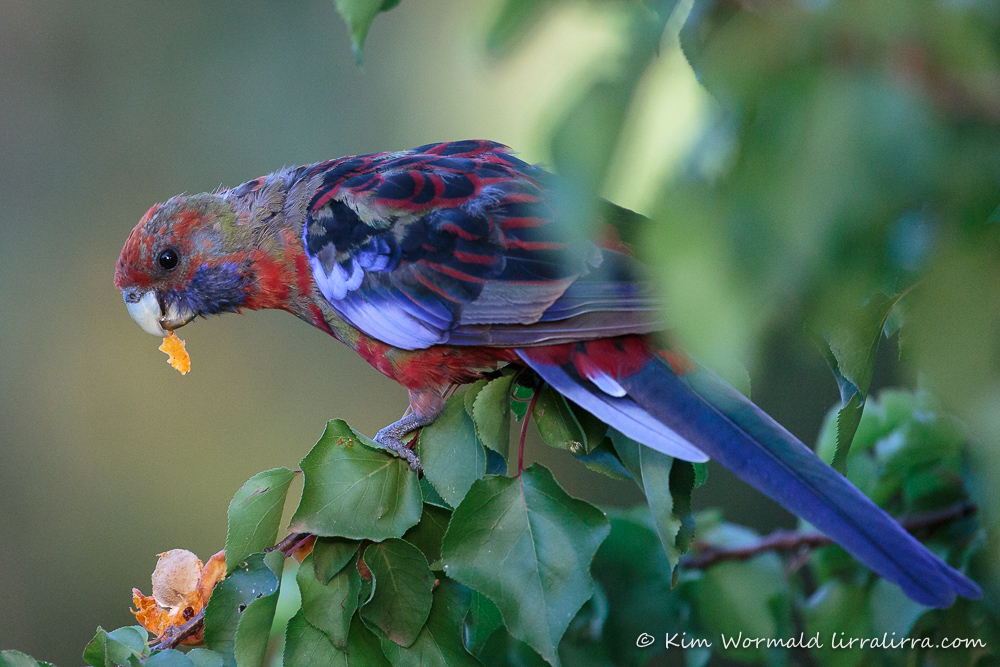
Crimson Rosella (Platycercus elegans) – leucistic
1/800, f/5.6, ISO 3200
If only the birds would eat this much of each apricot instead of the single nibble that so many of them get. This wider view of the crimson shows more normal adult colouring on its back (the juvenile bird in the first image has a green back) but it still has patches of soft grey and its legs appear paler than usual. It’s such an interesting looking bird, I think it would look amazing if someone talented with embroidery or patchwork used it as an inspiration – the variegated patches of colour look exquisite.

Crimson Rosella (Platycercus elegans) – leucistic
1/800, f/5.6, ISO 3200
I’ve included a close-up without the distracting leaves that shows more detail. Psittacine beak and feather disease can also cause feather anomalies but this bird is not unkempt and shows no damage to its bill or feathers so I’m confident that it isn’t unwell.
Happy birding
Kim
NB There is discussion going on behind the scenes about this bird; its colouring is not noted in the Handbook of Australian, New Zealand and Antarctic Birds (HANZAB).
PS There will be some duck news coming soon – I saw Australia’s first ever Tufted Duck on Monday which was amazing, and the Victorian Government has announced this year’s shooting season which has upset shooters and those of us opposed to duck shooting.
~ thank you for visiting and commenting
~ if you would like to join the subscribers receiving a weekly email when lirralirra is updated, please use the ‘subscribe’ box above right

Absolutely beautiful photos, Kim. May I ask what equipment you are using these days?
Thank you.
Hi Jane, I have two Canon cameras and a couple of long lenses. I’m thinking of adding what I use to at least one of the images each week, I used to do that. If you’d like to know more in the meantime please send me an email. I’m glad you like the images, thank you, Kim
They are the only ones to get apricots as my usual supplier said none this season. Envious of the clarity of the pictures.
My trees were laden, I’m sorry to hear you haven’t been so lucky, hopefully your supplier will be inundated next year
Wow!! these shots a stunning, I have always felt that my photo’s never are the same as the naked eye but think you have mastered nature in the photo’s Kim, they are beautiful all of them no matter what !!
That is a beautiful compliment Dona, it means a lot to me, thank you
I really like the dark background! Really shows off how stunning these birds are. I think sometimes I take our beautiful parrots for granted as we have so many lovely varieties commonly seen in our surroundings. The possibly leucisitic one is interesting, I don’t think I’ve ever seen one like that.
Re duck shooting, why they have called a season in the current climate is beyond me. The irony is that they have managed to enrage both sides with the restricted season!
I totally, totally agree about the duck shooting season – it sickens me that anyone could play politics with living creatures.
I also agree about how we take our parrots for granted, crimsons live at my property and yet I rarely photograph them. I want to keep an eye on the ‘leucistic’ one so maybe I’ll change my ways. You and Margot both like the dark backgrounds, it’s good to know I’m not the only one.
Superb photos Kim. The apricots attract the ants which also eat the apricots where the birds have pierced them, so I can understand that you might get bitten. But your perseverance has paid off with some great shots, even at the sacrifice of some lovely apricots. I’ve put a net over my tree which has fruit that will be ripe in just a few days, perfect for picking when the grandchildren arrive for a stay-over tomorrow. It’s Blackbirds that decimate my fruit. If it was these fellows, I’d be tempted to leave the net off to get some great photos like these. Great post Kim.
I hope your apricot harvesting went perfectly Neil. I’m thinking I should maybe net one of my trees next year, I’ve picked up a flyer about a bird/animal safe netting that looks good. I have blackbirds here but haven’t seen them make a single visit to the apricots.
Great shots as always!
Thank you Stephen
Hello Kim,
I have a weakness for hooked bills ! I love them all and especially the parakeets.
The young gourmet is really very handsome. I too will go towards leucism on this individual and I am curious to know why your observer says no.
I hope you will see The tufted duck again, we are used to them in France, they are wonderful.
We must fight every day against the hunting of birds and other animals
Hugs
The discussion about the rosella’s colouring has not been resolved, very interesting. Soon you’ll hopefully be seeing many members of the Australian parrot family
Truly beautiful – whatever the age or their plumage colouration.
And yes, the have a nibble and move on seems to be very, very common. I cannot (decades later) face fresh figs because it was my job when I was a child to clean up the partially consumed ones from a tree (the main culprits were silvereyes) in the backyard. In the summer heat they went mouldy very, very fast.
Duck hunting? Hiss and bloody spit.
That sounds like a truly revolting task you were given as a child, I imagine the ‘aroma’ would have been sickening. Infinite hissing and spitting for sure.
A beautiful set of photographs, Kim. I really like the contrast created by the dark background. That first piece of apricot or other fruit,(as I have noticed they do the same to the plums here) must be the best!
Thank you Margot, I’m glad you like the dark background. How interesting that you think the first peck is the sweetest because I’ve always thought they take a test bite and if they don’t think it’s quite ready they move on to the next one.
Your ethics yield great shots!
Thank you Cloudia, that is a comment I shall treasure
They love apricots as much as I do ! Beautiful photos once again
These apricots are particularly delicious Paul, maybe I should get some of the safety bird netting for one of the trees next year.